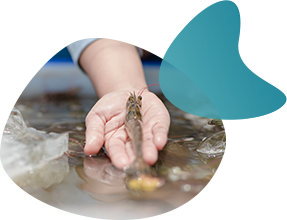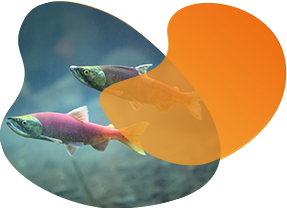Originally published : Mon, April 4, 2022 @ 10:59 PM
Updated : Mon, April 17, 2023 @ 1:33 PM
This is the first blog in a two-part series exploring solutions for infectious diseases in aquaculture. This blog post discusses treatment methods and introduces the concept of using genomic tools to breed for disease resistance. The second blog post explains how genomic technologies can be applied in breeding programmes to improve disease resistance traits.
Aquaculture is one of the fastest-growing sectors of the farmed-food industry, with annual production rising by nearly 4.5% over the past decade.1 Supplying roughly half of all the fish and shellfish eaten worldwide, commercial-scale fish production is a huge business and boost to local economies. Unfortunately, infectious diseases and parasites threaten production for aquaculture operations, leading to billions in lost revenue. Breeding for disease resistance is one of the primary goals of modern aquaculture programmes, and advancements in genomic technologies over the last decade are enabling breeders to make more accurate, timely decisions to support sustainable solutions for disease management.2
Effect of diseases on aquaculture production
The nature of aquaculture production, with fish confined in tanks, ponds or open water cages, facilitates the development and spread of infectious diseases, including sea lice, bacterial kidney disease, white spot syndrome virus (WSSV) and vibriosis, among others. The World Bank estimates that diseases cause more than $6 billion in economic losses for the aquaculture industry each year.3 Beyond their impact on animal health and associated production losses, infectious diseases in aquaculture can also have food security, human health and environmental consequences, especially in open water situations. The pesticides and antibiotics used to treat diseases can adversely affect marine life, and overuse can promote antibiotic-resistant disease populations.
Current disease treatment methods
In most cases, chemical treatments, including antibiotics and pesticides, are used to control infectious diseases in aquaculture production. Unfortunately, depending on the disease and infected species, there may be a lack of efficient therapeutic options. For those instances, selective breeding for disease resistance may offer viable solutions.1
Non-chemical management practices
Aquaculture operations employ biosecure protocols to help prevent and control diseases. For example, shrimp producers may plan their production schedules when water temperatures are warmer to reduce the risk of white spot syndrome virus. Another non-chemical disease management technique involves pumping fish into heated water, which can help remove sea lice. While this can be an effective strategy, it is also stressful for the fish.1 Employing breeding methods to select for disease- and parasite-resistant strains in commercial aquaculture programmes could offer a practical solution for managing infections.4 This simultaneously decreases stress on the fish, which in turn, promotes healthier growth rates.
Pesticides
Pesticides, including pyrethroids, are commonly used to control sea lice, one of the most debilitating salmon parasites. Although efficacious, pesticides also pose a risk for water and sediment quality, change microbial communities and biodiversity and threaten nontarget animal health.5 The aquaculture industry has relied heavily on organophosphate and pyrethroid insecticides over the past two decades, increasing the instance of pesticide-resistant parasitic lice populations1 and having negative environmental impacts.
Antibiotics
Antibiotics treat bacterial infections in aquaculture operations, and their use is expected to increase in the coming years to meet the intensive production demands of a growing population.6 The rising water temperatures associated with climate change could increase the pressure of emerging infectious diseases, leading to even more antibiotic use. Outbreaks of bacterial diseases such as edwardsiellosis, streptococcosis and acute hepatopancreatic necrosis disease are often observed with higher water temperatures.6
Similar to the situation on land, increased antibiotic use in aquaculture contributes to the selection, emergence and spread of drug-resistant pathogens, posing a direct threat to animal and human health by lowering drug efficacy. Breeding for disease-resistant aquaculture species could take the pressure off antibiotic use and give the industry another tool to battle infectious diseases.
Vaccines
While vaccines can prevent some diseases in fish, they are not viable for invertebrate species because their immune systems are less developed.1 Even where they may be therapeutically beneficial, vaccines are often cost-prohibitive and impractical due to the intense labour required for administration. Alternative effective and sustainable strategies, such as breeding for disease resistance, will help improve the economic efficiency of disease management.
Breeding for increased disease resistance
The environmental impacts of treatment options combined with the economic costs associated with lost revenue from disease infections make breeding for disease resistance an attractive goal for aquaculture breeders. The genetic variation available in aquaculture species presents an excellent opportunity for breeders to explore a rich trove of genetic material to mine for disease-resistance traits. Compared with the selective breeding done on domesticated animals, including chicken and cattle, most fish and shellfish species have so far seen minimal genetic improvements.1
 Breeding for disease resistance could offer a practical and sustainable alternative for disease management in the aquaculture industry. Disease resilience, the ability of a host to survive or cope with infectious disease, is a desirable trait for improvement. However, like many complex genetic traits, resilience is likely the result of multiple gene interactions.7 Relying on traditional selective breeding methods alone to identify and breed for this trait would likely lead to slow progress and intense costs for the breeding programme; thus, progressive aquaculture breeding programmes are exploring genomic breeding technologies to accelerate outcomes.
Breeding for disease resistance could offer a practical and sustainable alternative for disease management in the aquaculture industry. Disease resilience, the ability of a host to survive or cope with infectious disease, is a desirable trait for improvement. However, like many complex genetic traits, resilience is likely the result of multiple gene interactions.7 Relying on traditional selective breeding methods alone to identify and breed for this trait would likely lead to slow progress and intense costs for the breeding programme; thus, progressive aquaculture breeding programmes are exploring genomic breeding technologies to accelerate outcomes.
Genomic tools for improving disease-resistance traits
Genomic tools, such as PCR-based genotyping and targeted genotyping by sequencing, can support aquaculture breeders in achieving cost-effective disease-resistance screening to accelerate breeding outcomes. Genomic technologies can complement traditional breeding methods, and are especially beneficial when breeding for complex traits, such as disease resistance. One benefit of using molecular markers to screen breeding populations for disease resistance is that non-invasive sampling methods can be used, preserving the tested individual as a viable breeding candidate.
LGC Biosearch Technologies™ is a leader in genomic technologies for the aquaculture industry from PCR to next generation sequencing. We offer comprehensive services to support aquaculture breeding programmes to deliver improved stock, from convenient sample collection to DNA extraction, genotyping and data analysis. With quick turnaround times and the ability to screen large sample numbers, our genomic services deliver accurate, timely data to help breeders identify populations with natural resistance to specific diseases. Learn more about our all-inclusive service for aquaculture breeding programmes.
Check out the second blog post of the series which explores how genomic technologies can complement traditional breeding methods to improve disease-resistance traits in aquaculture species.
References
- Stokstad E. Tomorrow’s catch. Science. Published 2020. Accessed 15 February 2022. https://doi.org/10.1126/science.abf7615.
- Palaiokostas C. Predicting for disease resistance in aquaculture species using machine learning models. Aquaculture Reports. Volume 20. Published 2021. Accessed 15 February 2022. https://doi.org/10.1016/j.aqrep.2021.100660
- Saura M, Carabano M, Fernandez A, et al. Disentangling genetic variation for resistance and endurance to scuticociliatosis in turbot using pedigree and genomic information. Frontiers in Genetics. Published 2019. Accessed 15 February 2022. https://doi.org/10.3389/fgene.2019.00539
- Lillehammer M, Bangera R, Salazar M, et al. Genomic selection for white spot syndrome virus resistance in whiteleg shrimp boosts survival under an experimental challenge test. Sci Rep 10, 20571. Published 2020. Accessed 15 February 2022. https://doi.org/10.1038/s41598-020-77580-3.
- More W. Responsible chemical use in aquaculture. Global Seafood Alliance website. Published 2007. Accessed 15 February 2022. https://www.globalseafood.org/advocate/responsible-chemical-use-in-aquaculture/
- Reverter M, Sarter S, Caruso D, et al. Aquaculture at the crossroads of global warming and antimicrobial resistance. Nat Commun 11:1870. Published 2020. Accessed 15 February 2022. https://doi.org/10.1038/s41467-020-15735-6.
- Salama NKG and Rabe B. Developing models for investigating the environmental transmission of disease-causing agents within open-cage salmon aquaculture. Aquaculture Environment Interactions. 4:91-115. Published 2013. Accessed 15 February 2022. https://doi.org/10.3354/aei00077.


